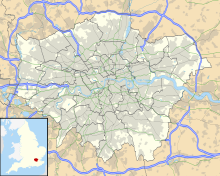Greek Street

Hogarth's 'Noon' from Four Times of the Day, showing the church in the background
|
|
| Former name(s) | Hogs Lane |
|---|---|
| Length | 0.2 mi (0.3 km) |
| Location | Soho, London |
| Postal code | W1 |
| Coordinates | 51°30′50″N 0°07′51″W / 51.5139°N 0.1308°WCoordinates: 51°30′50″N 0°07′51″W / 51.5139°N 0.1308°W |
| north end | Soho Square |
| south end | |
Greek Street is a street in Soho, London, leading south from Soho Square to Shaftesbury Avenue. The street is famous for its restaurants and cosmopolitan nature.
It is thought to take its name from a Greek church that was built in 1677 in adjacent Crown Street, now part of the west side of Charing Cross Road. The church is depicted in William Hogarth's 'Noon' from Four Times of the Day.
Although the street has several houses from the 18th century and earlier, it is mainly 19th-century in appearance.
No. 1 Greek Street is the House of St Barnabas, built in 1746. In 1811 it became the offices of the Westminster Commissioner for Works for Sewers. This is where Chief Engineer Sir Joseph Bazalgette started to work on the construction of the London sewerage system. By 1862 the house had been taken over by The House of Charity, which was established in 1846 to provide temporary accommodation for homeless people. Charles Dickens used the house and gardens as a model for the London lodgings of Dr Manette and Lucy in A Tale of Two Cities.
There has been a public house known as Pillars of Hercules at no. 7 since 1733. The current pub building sports some artwork by Invader and was long favoured by many figures in the London literary scene, including Martin Amis, Ian Hamilton, Julian Barnes and Ian McEwan. Indeed Clive James named his second book of literary criticism (At the Pillars of Hercules) after it.
...
Wikipedia

